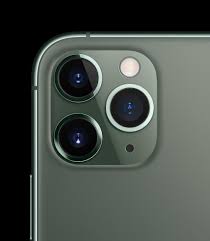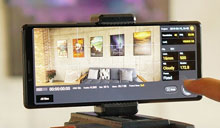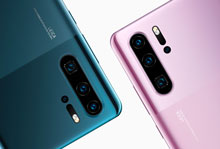Best Smartphone for Video Recording & Filmmaking
Smartphones have become pocket-sized power houses which have not only changed our lives, but changed the world too. We are now more connected than ever before. Not only that, but the device in our pocket or bag can be used for hundreds of every day tasks, including paying for lunch and watching the latest Netflix show.
Mobile Motion is a film festival dedicated to selecting and screening films shot purely on smartphones (or action cams). Every year we watch hundreds of films shot using these devices. So we should have some knowledge of which smartphones produce the best looking video.
I’m also a smartphone filmmaker myself, have shot 5 short films/episodes using a Samsung S8 and S9. So I have had hands-on experience, encountering most of the issues that come with smartphone filmmaking. Below I’ll reveal my choice for best smartphone for video recording, but first some things to consider:
Advantages of using a smartphone for video
What are the advantages of using a smartphone instead of the DSLR or mirrorless camera? As with every camera you choose, there are pros and cons of the device. Using a smartphone is no different.
In addition, the reason for using a smartphone should inform your later decisions when filming. Why not play to the advantages of your chosen device?
Cost
Smartphones aren’t always cheaper than a DSLR, but you have to remember they have 100s of features that other cameras don’t have. If you are going to have a smartphone anyway, then essentially you are getting a “free” video camera with it. You can’t use your DSLR for online banking or checking Facebook (not yet anyway).
Not only is the smartphone camera cheaper, but the extras like lenses, grips, tripods and gimbals are cheaper too.
Size
A smartphone weighs much less than a DSLR or mirrorless camera. It also takes up far less space. A DSLR weighs about 800 grams while a smartphone weighs about a quarter of that (about 200 grams). And that’s before you add a lens to your camera, while the smartphone comes with a lens (or lenses) included.
Versatility
The size, weight and virtual invisibility of the smartphone makes them ideal for filming “on the fly”. Because everyone has one, it’s much easier to film on the street or in a local cafe without disturbing anyone. It’s also very easy to mount or place your smartphone to get certain angles where using a DSLR would take longer.
Ease of use
Smartphones have had millions of dollars invested into making them easy to use. The video they produce “out of the box” is fine tuned to look great without having to grade or colour correct. In many models, AI has been developed which provides better dynamic range than any DSLR or even higher grade cameras.
Disadvantages of using a smartphone for video
Of course, filming with a smartphone is not all good news as DSLRs and mirrorless cameras do some things better. The question is always what you want to use your camera for and in what situations will you use it, mostly. But here are the downsides…
Lower video quality
In general, smartphones produce lower image quality than DSLRs and mirrorless cameras. This is mainly down to the size of the sensor, but is also due to the size of the lens.
Manual control
Manual control means being able to control exposure, focus and white balance settings of the camera. For example, setting ISO low so as to reduce or remove noise in low light situations. Many phones come with manual control, while other don’t.
These days, 3rd party apps allow us to have manual control on our smartphone but how well they work depends on the phone model (especially with Android phones).
No shallow depth of field
If you want that cinematic bokeh and blurry backgrounds you might have to use a DSLR or mirrorless with a long lens. The only way to get this effect using a smartphone is to get very close with the phone or use a Depth of Field adapter plus long lens. Adding tele conversion lenses like Moment (or other makes) just won’t add any significant shallow depth of field.
Not as good in low light
Again, due to the small sensor size smartphone cameras are not so good in low light situations. This means when you increase the ISO to brighten the image, you often get more video noise in the image.
Best smartphone cameras for video 2019
As we approach the end of 2019, most of the major phone makers have released their latest models. New models tend to bring new specs and new innovations, but we will have to wait until the middle of 2020 for more of those. It also looks as if smartphones are reaching the limits of quality, but perhaps there will be new science which opens up opportunities in the future.
Remember, a film selected for one of the biggest festivals in the world was shot with two iPhone 5s. The iPhone’s video quality has improved, mainly down to software AI features, but not by a huge amount. The advantages of newer phones are increased memory, increased resolution options, and higher processing power.
1. iPhone range

I’ve never owned an iPhone. Nor do we have anything to gain from promoting Apple products. However, most films we receive at MoMo are still shot on iPhones and for good reason. If we had to choose one smartphone to film with, the iPhone would still edge out the competition.
While other phone makers focus on the stills capability of their devices, Apple pay more attention to the video side of things too. The AI in recent iPhones does an amazing job at adding dynamic range to your video. For example, preventing the sky from blowing out (doing better than a Black Magic cinema camera).
The iPhone also integrates better with 3rd party camera apps such as FiLMiC Pro. Apple even invited FiLMiC to speak during the launch of their new iPhone 11 and iPhone 11 Pro (and Pro Max).
Read more: iPhone 11 Pro Designed for Smartphone Filmmakers
Note, you don’t have to use the latest iPhone to get great looking video. Oscar-winning Steven Soderbergh shot a feature film with an iPhone 7+ and another with an iPhone 8+. So, it seems that if you ask the real pros, the iPhone is indeed the best smartphone for video recording.
2. Sony Xperia 1 & Xperia 5

The Sony Xperia 1 is an Android phone made by a company that also makes cinema-grade cameras. But unlike RED, Sony have made a smartphone that is great for shooting video, as well as being functional in everyday use.
The phone is elongated to give a widescreen cinematic viewing experience. But more important for smartphone filmmakers is Sony’s own Cinema Pro app.
The Cinema Pro app gives you extensive manual control, without the need for 3rd party apps. This means no worrying whether FiLMiC Pro will provide manual controls without glitches. The Sony app lets you shoot at the wide 21:9 ratio with a range of manual settings such as frame rate, white balance, lens size, shutter speed and resolution.
However, the Xperia 1 also works well with FiLMiC Pro too. From what I have seen, the Xperia 1 works well in low light conditions. The cameras and sensors are on a level with Samsung’s phones, but with the added Cinema Pro app providing manual control, which is essential for good quality video.
DxOMark claim that the Xperia 1 is a poorer performer in low light conditions, but that is not what I’m seeing from sample videos. In some respects the Xperia 1 outperforms or equals the Samsungs.
Recording professional video on your smartphone is still a niche activity, which is perhaps why the Sony Xperia 1 has slipped under the radar. And maybe why it doesn’t come up on too many other best smartphone for video recording lists.
Note: Sony have just released the Xperia 5 which is about £150 cheaper than the Xperia 1. The phone appears to be almost the same, except smaller. So you’ll get a similar filmmaking experience for less – about £350 less than a iPhone 11 Pro and £400 less than the Samsung Galaxy S10 5G.
Read more: Sony Xperia 1, a smartphone made for filmmakers
3. Samsung S Range

Well known smartphone camera testers DxOMark recently gave the Samsung S10+ 5G the highest mark for any phone when shooting video. The Samsung S10+ 5G is a pretty big phone (or phablet), which may not suit your needs.
However, any of the recent Samsung phones will do a great job when shooting video. They perform best in terms of natural colour produced and in low light situations.
On the downside, Samsung recently decided to remove pro mode when shooting video. Previously, Samsung users had a full range of manual controls but now they have none (depending on the model and operating system). Third party camera apps work pretty well with Samsung devices, providing manual control, but some issues remain.
FiLMiC say there is “currently no access to tele lens on any Samsung devices”. Also note, if you want to shoot 4K at 60fps, FiLMiC cannot do so with devices using Snapdragon (Exynos is fine). This means Samsung phones with Snapdragon cannot have both manual control and 4K @ 60fps.
I’ve used Samsung S8, S8+ and S9 smartphones and found them to be great for filmmaking, once a 3rd party camera app is added. So you don’t necessarily need the latest model.
Note Samsung are one of the first to introduce “fake” depth of field for video. Called “live focus”, this depth of field mimicker attempts to mask people and apply blur to the rest of the image. While this works quite well in photos, in video the AI struggles to work out what should be blurred, resulting in the blurred effect jumping around the image at random.
NEW: How good is the Samsung Galaxy Note20 Ultra 5G for shooting video?
4. OnePlus range

OnePlus smartphones have been great for shooting video for a while now. Recently, the OnePlus 7 Pro improved on the quality of previous models. Again, OnePlus are a company who actively promote their devices as the best smartphone for video recording.
The OnePlus 7 Pro has a triple-camera setup, with a 26mm-equivalent lens with f/1.6 aperture and OIS, a 17mm-equivalent lens with f/2.2 aperture and a 78mm-equivalent tele lens with f/2.4 aperture and OIS. This phone also excels for fine detail preservation from its 4K footage capture at default settings. The autofocus system also performs well.
MoMo festival winner Giacomo Mantovani recently presented a series of masterclasses for OnePlus for beginning smartphone filmmakers. Giacomo’s film was awarded Best Documentary in 2016, so we are proud to see him now sharing his expert knowledge for new filmmakers.
Note, FiLMiC Pro says about the OnePlus range: “Many devices are prone to substantial chroma noise, especially in low light. Additionally, we cannot access frame rates above 30fps nor tele lenses on most OnePlus devices.”
5. Google Pixel range
![]()
Google have recently released the Pixel 4 and Pixel 4XL. Although the Google Pixel phones are rated well by DxOMark for video, we have found they have a weakness when it comes to low light filming. Feedback says the Pixel phones introduce more noise than other phones, even when pulling down the ISO using a 3rd party app.
There’s little extensive testing to be found out there when it comes to shooting video with the new Pixels, so we will have to wait an see if they have improved this. However, as far as we can tell Google haven’t done much to their Pixel cameras apart from adding more lenses.
Ultimately, Google – like many other Android smartphone manufacturers – have focused their camera features on shooting still images. When it comes to video, they aren’t thinking much beyond the casual user who wants to shoot quick clips of their family or friends.
Note, from FiLMiC Pro that while Pixel 1 and 2 smartphones work well with their app… “Pixel 3 series devices currently contain some instabilities at high frame rates and also exhibit some audio framework errors that become apparent when playing back footage on a desktop machine.”
6. Huawei range

With lenses made by Leica, the Huawei devices have had rave reviews from all over. While they may be awesome for still photos, for shooting video they’re just not that great. At least, compared to the other high priced, top range smartphones. With low light issues and artifacts created by the Huawei AI and other software, they can’t be included as a superior device for filmmaking.
FiLMiC Pro also say… “Most Huawei devices do not properly support frame rates below 30fps. As such, we do not offer 24 and 25fps configurations within FiLMiC Pro on devices containing this issue.” So when it comes to having manual control, Huawei shooters will be without the 24fps film-look frame rate.
All that negativity aside, the top Huawei phones such as the P30 Pro do produce good video. Their auto focus and inbuilt stabilisation being particularly useful. However, these strengths are part of it’s weakness when you just want manually controlled, software-free video.
If you’re intending to shoot video on the fly and want immediate results, a Huawei might be for you. However, if you intend to spend time editing, grading, adding your own stabilization in post and so on, you’re better off with one of the top 4 devices.
Best Budget Smartphone for Shooting Video
Those are the top 6 Smartphone brands for shooting video, if you have no budget restrictions. Although, you don’t need to purchase the latest model to shoot great video. That said, if you want a new smartphone and don’t want to spend so much, there are alternatives.
One of the best budget smartphones for shooting video is the Xiaomi Pocophone F1. DxOMark rates it highly, as do FiLMiC Pro themselves. So, if you are looking for manual controls, you can’t do much better than a recommend from the leading 3rd party camera app makers.
The Xiaomi may not be the best smartphone for video recording, but it could be a great compromise between quality and cost.
Read more: Xiaomi Pocophone F1 best budget smartphone for shooting video
Smartphone Video – Beginner to Advanced
If you want to know more about smartphone filmmaking, my book Smartphone Videography – Beginners to Advanced is now available to download for members on Patreon. The book is 170 pages long and covers essential smartphone filmmaking topics:
Things like how to get the perfect exposure, when to use manual control, which codecs to use, HDR, how to use frame rates, lenses, shot types, stabilisation and much more. There’s also my Exploring the Film Look Guide as well as Smartphone Colour Grading.
Members can also access all 5 episodes of our smartphone shot Silent Eye series, with accompanying screenplays and making of podcasts. There’s other materials too and I will be adding more in the future.
If you want to join me there, follow this link.
Simon Horrocks
Simon Horrocks is a screenwriter & filmmaker. His debut feature THIRD CONTACT was shot on a consumer camcorder and premiered at the BFI IMAX in 2013. His shot-on-smartphones sci-fi series SILENT EYE featured on Amazon Prime. He now runs a popular Patreon page which offers online courses for beginners, customised tips and more: www.patreon.com/SilentEye



Lol…u missed LV 30..40 n 50 series. It is one of the best film shooting mobile with own app for manual control. Pls improve your knowledge regarding it. Huh
Fantastically informative, looking to start filming using a smartphone so I found this a great resource!
hi Marcus! Glad to have you as part of the smartphone filmmaking family
Thanks Simon, a quick question, if I was filming with a two camera set up I don’t suppose it’s a good idea to use two different phone brands if you want a continuity of colour etc. Or could I easily match up the footage in post?
It might work, but it would be preferable to use the same brand
Lg v30 v40 v50 must be included.
[…] i video in condizioni di scarsa luminosità del Sony Xperia 1 sono considerati i migliori finora MoMo-Filmfest. Il suo successore Sony Xperia 1 II è già stato […]
Nice review, and youre right, apart from one thing, it doesnt beat a Blackmagic camera in DR, and Blackmagic Doesnt make Dslr
where is LG V series phones !!!!
Please is tecno phones ideal for smart phone film making
LG V series with its kicking manual video *MUST* be in this list.
how about vivo X series?
I’ve been watching videos on YouTube showing life as it happens shot with 2021 versions of various phones. They look great. The authors are not “filmmakers” in any formal sense, and their stuff is shot with available light using handheld gimbals or no gimbals at all. Given a good script and proper movie technique, a “film” shot this way should easily transcend the technical limitations of the technology. Does this not portend a time when most things are shot on locations and requiring almost no lighting gear or other cumbersome gadgetry?